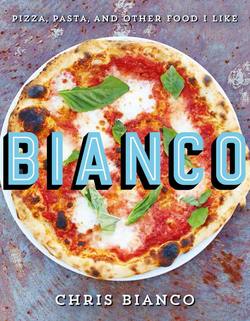Читать книгу Bianco: Pizza, Pasta and Other Food I Like - Chris Bianco - Страница 13
ОглавлениеFor me, the marinara is the most difficult pizza to make, but it is also without a doubt my favorite one. Its minimalism at first glance could easily belie its complexity. The difficulty lies in two factors: The first is a matter of chemistry. Unlike the Margherita, the marinara does not have the luxury of cheese; it’s just sauce, herbs, and garlic, twice as much sauce, in fact, as the Margherita. So it’s saucier than your usual pie, and there is a little bit of a dance involved. You want to hit that sweet spot with the cooking time where the pizza is still moist with sauce but not soggy. The second bit of difficulty also goes back to that no-cheese thing. In a marinara, there are no distractions—there is nowhere to hide. It is a study in minimalism.
And that’s why it is so near and dear to my heart. It is a pizza of ultimate nakedness, transparency, humility, and grace, made with the most humble of ingredients. It is about transforming a few pantry staples into a sublime whole so much greater than the sum of its parts, through an act of sustained focus and appreciation for the task at hand. If I had the pleasure of cooking for you and you said, “Chris, make anything!” this would be my go-to.
Makes one 10-inch pizza
One ball Pizza Dough, rested and ready to shape
¾ cup Crushed Tomato Sauce
A pinch of dried oregano, preferably wild
2 garlic cloves, sliced paper-thin
1 or 2 fresh basil leaves
Extra virgin olive oil, for drizzling
Coarse sea salt
Crushed red pepper flakes (optional)
Position a rack in the lower third of the oven (remove the rack above it) and place a pizza stone on it. Turn up your oven to its maximum setting and let that baby preheat for a solid hour.
Once the oven is preheated, grab a pizza peel and give it a nice, light dusting of flour. Shape the dough as directed and set the prepared dough on the peel. Jerk the peel to make sure it’s not sticking. If it is, lift the dough and dust the underside with extra flour (or, if no one is looking, blow under it very gently). Tuck and shape it until it’s a happy circle.
Spoon the tomato sauce evenly over the pizza, using the back of the spoon to spread the sauce, starting from the center and stopping about ¾ inch—a fat thumb’s width—from the edges. (With a hand-crushed tomato sauce, the consistency of the sauce over the pizza’s surface will be uneven. It’s inevitable.) Add the oregano, pinching it firmly as you sprinkle it over the sauce to activate its aroma. Scatter the sliced garlic evenly over the top. Finally, bruise the basil leaves, tear them (for little nuggets of brightness), and place them in the center of the pizza. Drizzle on a little extra virgin olive oil.
Open the oven and, tilting the peel just slightly, give it a quick shimmy-shake to slide the pizza onto the pizza stone. Bake the pizza for 10 to 15 minutes, until the crust is crisp and golden brown. This is a fairly wet pizza, so it may take a little longer than others.
Remove the pizza with the peel, drizzle on a little olive oil, and finish with a sprinkle of coarse sea salt. You could even dust it with a crumble of red pepper flakes for a slight quickening of its cadence in your mouth. Enjoy immediately!
WILD OREGANO
We use dried local wild oregano in a range of dishes. It’s dried on the stem, and we just crumble the leaves into the pot (or over a pizza), releasing all the intense fragrance and the flavorful oil. Dried wild oregano on the stem from Greece and other areas of the Mediterranean is available from some gourmet markets and online spice purveyors. If you can’t get it, use good-quality dried oregano, but be sure to crush the leaves between your fingertips as you add them to whatever you are cooking.
